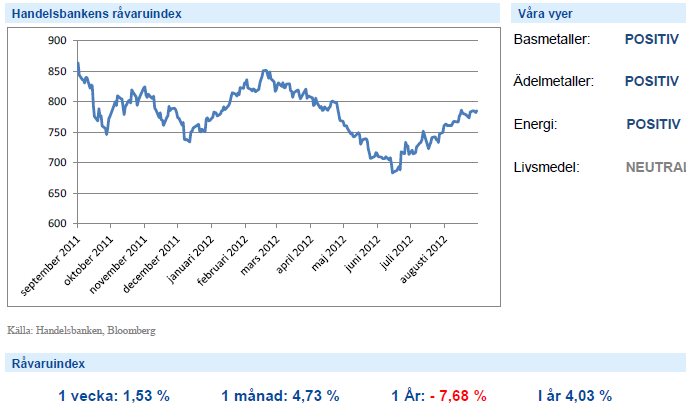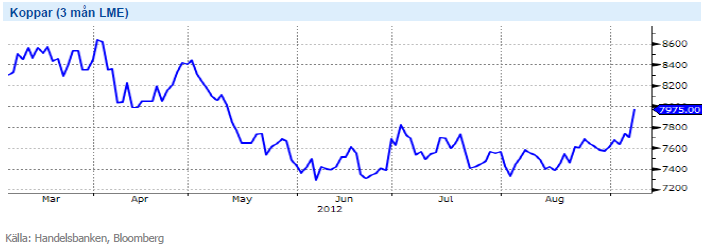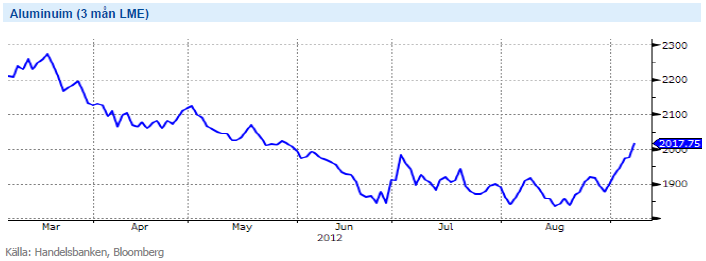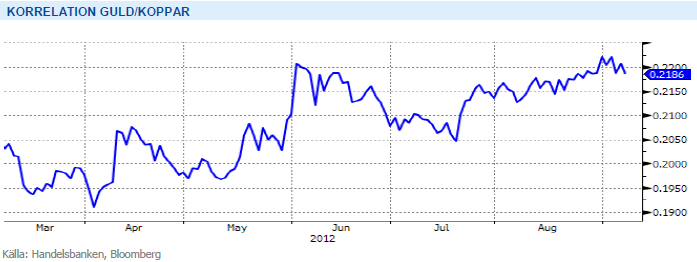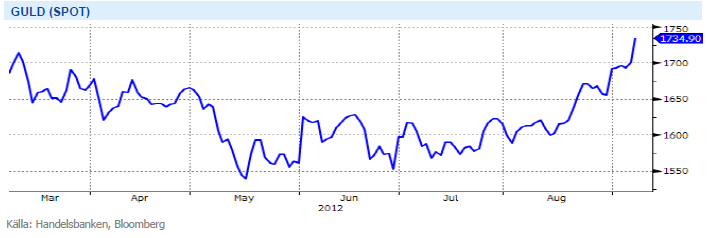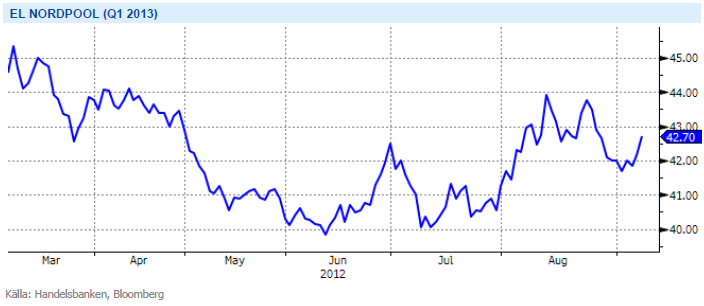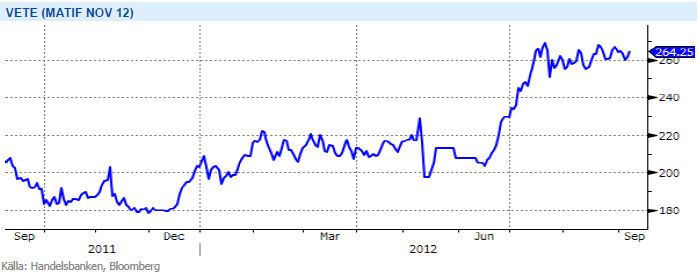Analys
SHB Råvarubrevet 7 september 2012
 Råvaror Allmänt
Råvaror Allmänt
ECB ger stöd åt råvaror
Råvaror har, precis som övriga marknaden fått bra stöd under veckan av ECB-mötet. Detta trots att utfallet av ECB-mötet blev i linje med tidigare läckta uppgifter. Det tog lite tid men sedan blev det kraftiga marknadsrörelser uppåt. Efter att amerikanska centralbankens chef Bernankes dito prestation förra veckan är de två stora riskerna på nedsidan ”bortpratade”.
Makroekonomin hamnar i skymundan när centralbankerna gör så här stora marknadspåverkande ingrepp och vi förväntar oss att det kommer ge stöd åt riskhandlade tillgångar som råvaror under en tid framöver. Nästa vecka kommer mer från Fed, torsdagen den 13e släpper man räntebesked och kl 20:15 har Bernanke presskonferens. Guldet har åter fått styrfart efter att centralbankerna börjat agera på problemen i realekonomin och vi räknar med att det fortsätter.
Basmetaller
Basmetallerna på uppgång
Aluminium och koppar har haft rejäla uppgångar under veckan; aluminium är upp drygt 5 % och koppar är upp drygt 3 %. Risksentimentet har givetvis lyft priserna men även rapporter om ökad efterfrågan från industrin har hjälpt till.
När det gäller aluminium står USA för 9 % av konsumtionen och framförallt bilproducenterna och maskintillverkare har visat på större inköp. Det som har stött kopparpriset är att Kina annonserat flera kopparintensiva infrastrukturprojekt. Vi är fortsatt positiva till basmetaller på dessa nivåer, framförallt beroende på en starkare världskonjunktur och Kinas återhämtning.
Kinas makrodata har ännu inte bjudit på positiva överraskningar men Kinas dåliga konjunktur är nu inprisad i råvarorna och de faller inte när kinadata kommer ut. Vi tycker att basmetallerna, som har 50 % exponering mot Kina, handlas på attraktiva nivåer och de bjuder på en intressant uppsida när Kinas konjunkturåterhämtning kommer. Vi ser även att den positiva riskaptiten, drivet av centralbankernas stimulanser ger stöd åt prisbilden.
Lång BULL BASMET H
Ädelmetaller
Centralbankernas stimulanser driver guldet
Dagens amerikanska arbetslöshetssiffror satte bra fart på guldpriset och det har i eftermiddag stigit över två procent. Som vi skriver i inledningen av veckans brev tror vi att centralbanksstimulanser kommer att driva priset ytterligare på ädelmetaller, och dagens arbetslöshetssiffror förstärker tron på dessa stimulansåtgärder.
Ädelmetaller har fortsatt hög korrelation med basmetaller, och sedan sommaren har guld och koppar rört sig helt hand i hand (se bild), och vi ser ingen anledning till att denna korrelation ska släppa i närtid.
Vårt ädelmetallsindex har stigit med 10 % under den senaste månaden där inte minst silver har visat på styrka med närmare 17 % i värdestegring. I platinumgruvan i sydafrika fortsätter oroligheterna vilket har fått platinumpriset att rusa, nästan 14 % upp på en månad.
Vi på Handelsbanken tror att centralbankernas fortsatta stimulansåtgärder kommer fortsätta att ge stöd åt ädelmetaller, lett av guld.
Lång ADELMET H
Energi
Produktionsstörningar ger stöd åt oljan
Oljemarknaden backar 1.5 procent under veckan efter sämre amerikanska arbetslöshets siffror och rykten kring att delar av landets strategiska lager kan komma ut på marknaden. Faktorer som fallande lagersiffror under augusti (-7.4 miljoner fat mot -5.3 förväntat från US DOE), ökad spänning mellan Israel och Iran samt uppreviderade förbrukningssiffror (+2.7 procent y-o-y) och OPECs låga reservkapacitet (idag 1.4 miljoner fat / dag eller 1.5 procent att jämföra med 3 procent under 1H2012 och 1 procent 2008 när Brent nådde 147 dollar) visar på att marknaden är fortsatt väldigt känslig för produktionsstörningar. Detta är anledningen till varför man nu talar så mycket om de strategiska lagren USA kan komma att använda för att få situationen under kontroll. Vi ser dock den låga reservkapaciteten som ett fortsatt problem för marknaden.
Elpriset pressas fortsatt av stora nederbördsmängder, hög vindkraftsproduktion samt återstart av både Forsmark 1 och Oskarshamn 3. Även kommande 10 dagars period ser ut att ge mer regn än normalt, uppemot 9.7 TWh mot normala 6.1 TWh, vilket skulle innebära att energibalansen stärks med ytterligare 2.5 TWh till +9.5 TWh mot slutet av vecka 37. När inte heller kolet förväntas stiga nämnvärt är det svårt att se någon direkt potential för uppgång på den korta elkurvan. SHB Power Index följer numer kontraktet Q1 2013 som stängde på 42.70 (5.5 euro över Q4 2012). Att däremot köpa den längre kurvan på nivåer om 34.5 öre / kWh måste däremot ses som väldigt attraktiva nivåer.
Olja är den mest finansiellt handlade råvaran, i en redan stram marknad med störningar på utbudssidan tror vi att ökad riskvilja hos investerare efter ECBs och Feds aktioner kan driva olja ytterligare. Vi bedömer dock att det finns en finansiellt driven riskpremie i oljan på grund av oron kring Israels krigsvilja, denna kan snabbt pysa ut om situationen lugnar ner sig.
Lång OLJA H
Livsmedel
Fortsatt torrt i Australien
I USA är skörden av vårvete nästan helt klar och kvalitetsnivåer uppges överlag vara tillfredställande. Nu kommer allt mer fokus läggas på sådden av höstvete, för vilket det idag inte finns någon jättestor oro även om mer nederbörd är önskvärt. I Australien är dock fortfarande oron ganska stor, i stort sett inget regn väntas under de närmaste två veckorna samtidigt som grödan går in i en allt mer kritisk period. Ett torrt år i Australien sänker ofta avkastningsnivån 30-40 procent så marknaden lär följa detta noggrant.
Skörden fortsätter i Ryssland med torrt väder så ingen fördröjning att nämna för det vete som står kvar ute på fält, kvalitetsnivån uppges dock vara ganska varierande. Längst ner i söder har sådden startat (ca. 15% klart) under vad jag hört utmärkta förhållanden. I veckan har de spannmålsexporterande företagen i Ukraina kommit överens med regeringen om att frivilligt begränsa exporten av vete innevarande säsong till 4 miljoner ton, vilket innebär att USDA i nästa veckas rapport får justera ned sina förväntningar med 2 miljoner ton. För tillfället kan det vara svårt att se varför priserna på vete ska gå ned på kort sikt, inte minst på grund av problemen i Australien. Ser vi lite längre fram och funderar över prisnivån vid skörd nästa år är det däremot svårare att se varför dagens historiskt sett höga nivå ska hålla i sig. Dagens höga priser bör leda till att de som kan ökar sin odlade areal och även om (som vanligt) väldigt mycket kan hända innan skörd har i alla fall sådden fått en väldigt bra start överallt.
Torka i Västafrika och spekulation om El Ninos negativa inverkan på den kommande kakaoskörden där och i Indonesien, har fått kakao priset att stiga i veck-an. Kakao handlar nu på 10mån högsta. ICO (International Coffee Organization) presenterade sin rapport för augusti tidigare i veckan. Estimatet för den totala kaffeproduktionen 2011/12 är ca 132,7 miljoner säckar, vilket är något färre än året innan (-1,2 %).
För apelsinjuicens del är det stor fokus på den pågående orkansäsongen. Priset på apelsinjuice har stärkts under den gångna veckan och ”Leslie” är den senaste av orkaner som kan komma att drabba apelsinodlingarna i Florida de kommande dagarna.
Handelsbankens Råvaruindex
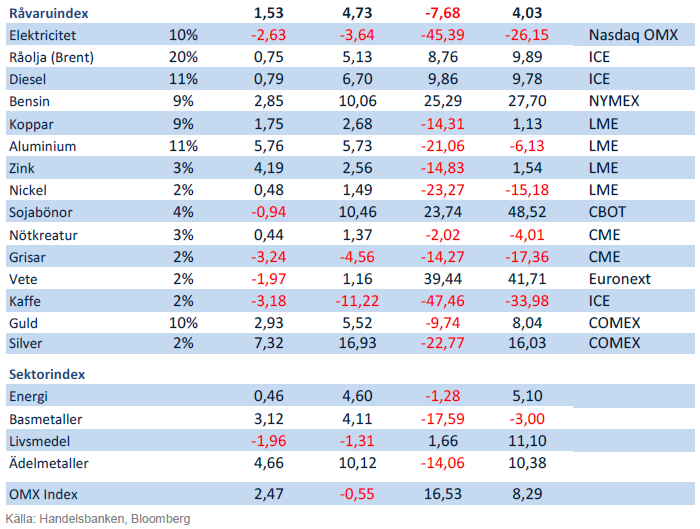
Handelsbankens råvaruindex består av de underliggande indexen för respektive råvara. Vikterna är bestämda till hälften från värdet av global produktion och till hälften från likviditeten i terminskontrakten.
[box]SHB Råvarubrevet är producerat av Handelsbanken och publiceras i samarbete och med tillstånd på Råvarumarknaden.se[/box]
Ansvarsbegränsning
Detta material är producerat av Svenska Handelsbanken AB (publ) i fortsättningen kallad Handelsbanken. De som arbetar med innehållet är inte analytiker och materialet är inte oberoende investeringsanalys. Innehållet är uteslutande avsett för kunder i Sverige. Syftet är att ge en allmän information till Handelsbankens kunder och utgör inte ett personligt investeringsråd eller en personlig rekommendation. Informationen ska inte ensamt utgöra underlag för investeringsbeslut. Kunder bör inhämta råd från sina rådgivare och basera sina investeringsbeslut utifrån egen erfarenhet.
Informationen i materialet kan ändras och också avvika från de åsikter som uttrycks i oberoende investeringsanalyser från Handelsbanken. Informationen grundar sig på allmänt tillgänglig information och är hämtad från källor som bedöms som tillförlitliga, men riktigheten kan inte garanteras och informationen kan vara ofullständig eller nedkortad. Ingen del av förslaget får reproduceras eller distribueras till någon annan person utan att Handelsbanken dessförinnan lämnat sitt skriftliga medgivande. Handelsbanken ansvarar inte för att materialet används på ett sätt som strider mot förbudet mot vidarebefordran eller offentliggörs i strid med bankens regler.
Analys
Increasing risk that OPEC+ will unwind the last 1.65 mb/d of cuts when they meet on 7 September

Pushed higher by falling US inventories and positive Jackson Hall signals. Brent crude traded up 2.9% last week to a close of $67.73/b. It traded between $65.3/b and $68.0/b with the low early in the week and the high on Friday. US oil inventory draws together with positive signals from Powel at Jackson Hall signaling that rate cuts are highly likely helped to drive both oil and equities higher.

Ticking higher for a fourth day in a row. Bank holiday in the UK calls for muted European session. Brent crude is inching 0.2% higher this morning to $67.9/b which if it holds will be the fourth trading day in a row with gains. Price action in the European session will likely be quite muted due to bank holiday in the UK today.
OPEC+ is lifting production but we keep waiting for the surplus to show up. The rapid unwinding of voluntary cuts by OPEC+ has placed the market in a waiting position. Waiting for the surplus to emerge and materialize. Waiting for OECD stocks to rise rapidly and visibly. Waiting for US crude and product stocks to rise. Waiting for crude oil forward curves to bend into proper contango. Waiting for increasing supply of medium sour crude from OPEC+ to push sour cracks lower and to push Mid-East sour crudes to increasing discounts to light sweet Brent crude. In anticipation of this the market has traded Brent and WTI crude benchmarks up to $10/b lower than what solely looking at present OECD inventories, US inventories and front-end backwardation would have warranted.
Quite a few pockets of strength. Dubai sour crude is trading at a premium to Brent crude! The front-end of the crude oil curves are still in backwardation. High sulfur fuel oil in ARA has weakened from parity with Brent crude in May, but is still only trading at a discount of $5.6/b to Brent versus a more normal discount of $10/b. ARA middle distillates are trading at a premium of $25/b versus Brent crude versus a more normal $15-20/b. US crude stocks are at the lowest seasonal level since 2018. And lastly, the Dubai sour crude marker is trading a premium to Brent crude (light sweet crude in Europe) as highlighted by Bloomberg this morning. Dubai is normally at a discount to Brent. With more medium sour crude from OPEC+ in general and the Middle East specifically, the widespread and natural expectation has been that Dubai should trade at an increasing discount to Brent. the opposite has happened. Dubai traded at a discount of $2.3/b to Brent in early June. Dubai has since then been on a steady strengthening path versus Brent crude and Dubai is today trading at a premium of $1.3/b. Quite unusual in general but especially so now that OPEC+ is supposed to produce more.
This makes the upcoming OPEC+ meeting on 7 September even more of a thrill. At stake is the next and last layer of 1.65 mb/d of voluntary cuts to unwind. The market described above shows pockets of strength blinking here and there. This clearly increases the chance that OPEC+ decides to unwind the remaining 1.65 mb/d of voluntary cuts when they meet on 7 September to discuss production in October. Though maybe they split it over two or three months of unwind. After that the group can start again with a clean slate and discuss OPEC+ wide cuts rather than voluntary cuts by a sub-group. That paves the way for OPEC+ wide cuts into Q1-26 where a large surplus is projected unless the group kicks in with cuts.
The Dubai medium sour crude oil marker usually trades at a discount to Brent crude. More oil from the Middle East as they unwind cuts should make that discount to Brent crude even more pronounced. Dubai has instead traded steadily stronger versus Brent since late May.
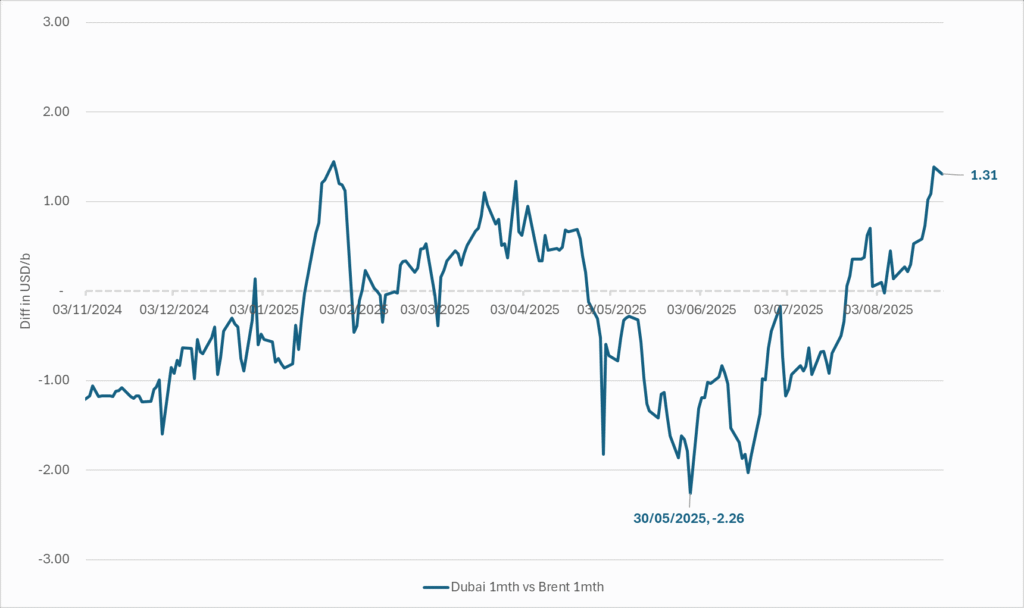
The Brent crude oil forward curve (latest in white) keeps stuck in backwardation at the front end of the curve. I.e. it is still a tight crude oil market at present. The smile-effect is the market anticipation of surplus down the road.
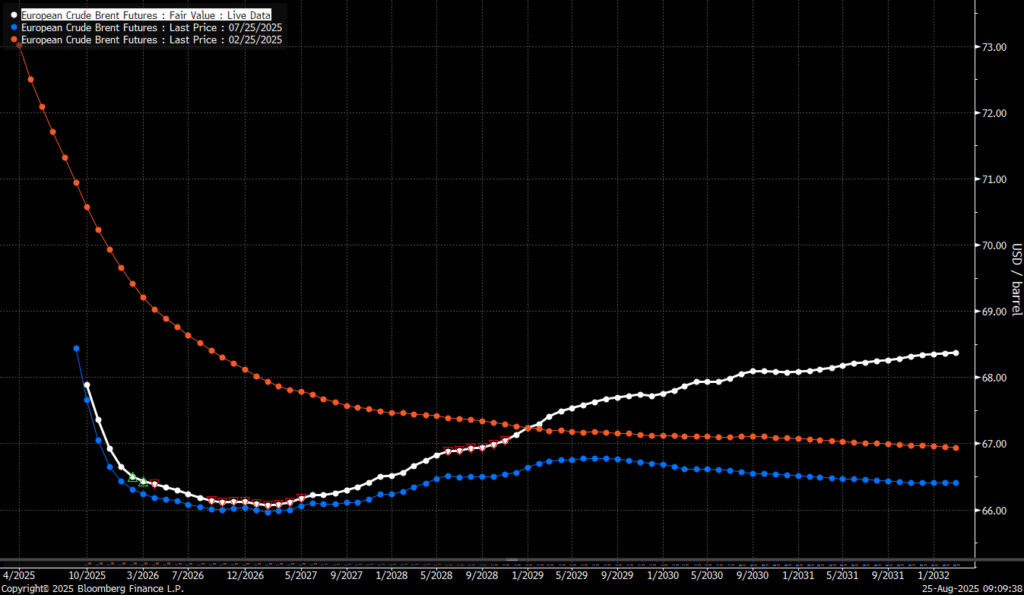
Analys
Brent edges higher as India–Russia oil trade draws U.S. ire and Powell takes the stage at Jackson Hole

Best price since early August. Brent crude gained 1.2% yesterday to settle at USD 67.67/b, the highest close since early August and the second day of gains. Prices traded to an intraday low of USD 66.74/b before closing up on the day. This morning Brent is ticking slightly higher at USD 67.76/b as the market steadies ahead of Fed Chair Jerome Powell’s Jackson Hole speech later today.

No Russia/Ukraine peace in sight and India getting heat from US over imports of Russian oil. Yesterday’s price action was driven by renewed geopolitical tension and steady underlying demand. Stalled ceasefire talks between Russia and Ukraine helped maintain a modest risk premium, while the spotlight turned to India’s continued imports of Russian crude. Trump sharply criticized New Delhi’s purchases, threatening higher tariffs and possible sanctions. His administration has already announced tariff hikes on Indian goods from 25% to 50% later this month. India has pushed back, defending its right to diversify crude sourcing and highlighting that it also buys oil from the U.S. Moscow meanwhile reaffirmed its commitment to supply India, deepening the impression that global energy flows are becoming increasingly politicized.
Holding steady this morning awaiting Powell’s address at Jackson Hall. This morning the main market focus is Powell’s address at Jackson Hole. It is set to be the key event for markets today, with traders parsing every word for signals on the Fed’s policy path. A September rate cut is still the base case but the odds have slipped from almost certainty earlier this month to around three-quarters. Sticky inflation data have tempered expectations, raising the stakes for Powell to strike the right balance between growth concerns and inflation risks. His tone will shape global risk sentiment into the weekend and will be closely watched for implications on the oil demand outlook.
For now, oil is holding steady with geopolitical frictions lending support and macro uncertainty keeping gains in check.
Oil market is starting to think and worry about next OPEC+ meeting on 7 September. While still a good two weeks to go, the next OPEC+ meeting on 7 September will be crucial for the oil market. After approving hefty production hikes in August and September, the question is now whether the group will also unwind the remaining 1.65 million bpd of voluntary cuts. Thereby completing the full phase-out of voluntary reductions well ahead of schedule. The decision will test OPEC+’s balancing act between volume-driven influence and price stability. The gathering on 7 September may give the clearest signal yet of whether the group will pause, pivot, or press ahead.
Analys
Brent sideways on sanctions and peace talks

Brent crude is currently trading around USD 66.2 per barrel, following a relatively tight session on Monday, where prices ranged between USD 65.3 and USD 66.8. While expectations of higher OPEC+ supply continue to weigh on sentiment, recent headlines have been dominated by geopolitics – particularly developments in Washington.

At the center is the White House meeting between Trump, Zelenskyy, and several key European leaders. During the meeting, Trump reportedly placed a direct call to Putin to discuss a potential bilateral sit-down between Putin and Zelenskyy, which several European officials have said could take place within two weeks.
While the Kremlin’s response remains vague, markets have interpreted this as a modestly positive signal, with both equities and global oil prices holding steady. Brent is marginally lower since yesterday’s close, while U.S. and Asian equity markets remain broadly flat.
Still, the political undertone is shifting, and markets may be underestimating the longer-term implications. According to the NY times, Putin has proposed a peace plan under which Russia would claim full control of the Donbas in exchange for dropping demands over Kherson and Zaporizhzhia – territories it has not yet seized.
Meanwhile, discussions around Ukraine’s long-term security framework are starting to take shape. Zelenskyy appeared encouraged by Trump’s openness to supporting a post-war security guarantee for Ukraine. While the exact terms remain unclear, U.S. special envoy Steve Witkoff stated that Putin had signaled willingness to allow Washington and its allies to offer Kyiv a NATO-style collective defense guarantee – a move that would significantly reshape the regional security landscape.
As diplomatic efforts gain momentum, markets are also beginning to assess the potential consequences of a partial or full rollback of U.S. sanctions on Russian energy. Any unwind would likely be gradual and uneven, especially if European allies resist or delay alignment. The U.S. could act unilaterally by loosening financial restrictions, granting Russian firms greater access to Western capital and services, and effectively neutralizing the price cap mechanism. However, the EU embargo on Russian crude and products remains a more immediate constraint on flows – particularly as it continues to tighten.
Even if the U.S. were to ease restrictions, Moscow would remain heavily reliant on buyers like India and China to absorb the majority of its crude exports, as European countries are unlikely to quickly re-engage in energy trade. That shift is already playing out. As India pulls back amid newly doubled U.S. tariffs – a response to its ongoing Russian oil purchases – Chinese refiners have stepped in.
So far in August, Chinese imports of Russia’s Urals crude – typically shipped from Baltic and Black Sea ports – have nearly doubled from the YTD average, with at least two tankers idling off Zhoushan and more reportedly en route (Kpler data). The uptick is driven by attractive pricing and the absence of direct U.S. trade penalties on China, which remains in a delicate tariff truce with Washington.
Indian refiners, by contrast, are notably more cautious – receiving offers but accepting few. The takeaway is clear: China is acting as the buyer of last resort for surplus Russian barrels, likely directing them into strategic storage. While this may temporarily cushion the effects of sanctions relief, it cannot fully offset the constraints imposed by Europe’s ongoing absence.
As a result, any meaningful boost to global supply from a rollback of U.S. sanctions on Russia may take longer to materialize than headlines suggest.
-

 Nyheter4 veckor sedan
Nyheter4 veckor sedanKopparpriset i fritt fall i USA efter att tullregler presenterats
-
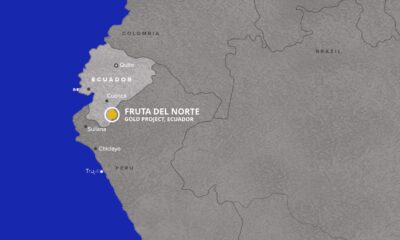
 Nyheter4 veckor sedan
Nyheter4 veckor sedanLundin Gold rapporterar enastående borrresultat vid Fruta del Norte
-

 Nyheter4 veckor sedan
Nyheter4 veckor sedanStargate Norway, AI-datacenter på upp till 520 MW etableras i Narvik
-

 Nyheter4 veckor sedan
Nyheter4 veckor sedanMängden M1-pengar ökar kraftigt
-

 Nyheter2 veckor sedan
Nyheter2 veckor sedanOmgående mångmiljardfiasko för Equinors satsning på Ørsted och vindkraft
-
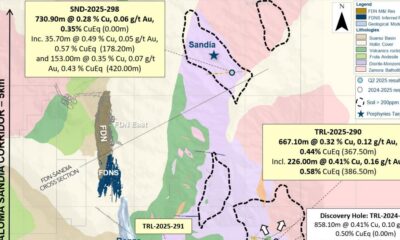
 Nyheter3 veckor sedan
Nyheter3 veckor sedanLundin Gold hittar ny koppar-guld-fyndighet vid Fruta del Norte-gruvan
-

 Nyheter3 veckor sedan
Nyheter3 veckor sedanGuld stiger till över 3500 USD på osäkerhet i världen
-

 Nyheter3 veckor sedan
Nyheter3 veckor sedanAlkane Resources och Mandalay Resources har gått samman, aktör inom guld och antimon


